By Shawn Phillips
Free Muscle Media 2000 Special Report!
Maybe it’s irreverent to compare bodybuilding to a religion, but what else can it be if it isn’t a religion? Certainly no Bible thumpers were ever more fervent or more passionate about their faith than a bodybuilder is about the gym. And if bodybuilding is like a religion, complete with its Olympian deities, then the bench press is the altar of our little sect. It’s where our worth as physique athletes is rneasured, and when some powerful presence starts throwing 45 pound plates on the bar and that sweet sound of clanging metal (was any choir ever more uplifting?) hits our ears, we stop, listen, and most of all, look. After all, the bench press has mystique.
Why exactly the bench press got to be so glamorous is unknown. It’s not exactly like we perform this movement in everyday life. Maybe our genetic predecessors were often forced to bench press wayward rocks or fallen trees off their chests, but the closest most of us come to doing a bench press in modern life is pushing a salesman away. Still, the question most commonly asked of bodybuilders in the casual grocery-store checkout-line conversation is, and always has been, “How much can you bench press?”
Truth be told, the deadlift is a far better indicator of overall strength, but to the disappointment of chiropractors everywhere, few bodybuilders do the deadlift. Regardless, it’s not the objective of this article to investigate the phenomenon but, instead, to go with it. The purpose of this Muscle Media 2000 Special Report is to help you add up to 40 pounds to your max bench press. Using this program, I was able to take my bench press from a max of 350 pounds to a personal best of 405 pounds in 6 weeks. Obviously, 55 pounds constitutes an exceptional gain, one that you might not be able to get, but I guarantee that you will add a substantial amount to your one- repetition max. And with that strength gain comes added muscle, most notably in the chest, shoulders, and triceps.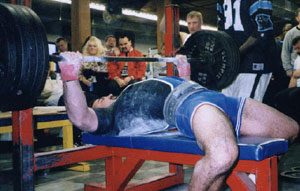 A Few Words About
A Few Words About
Genetic Potential
Your strength in any lift is determined by both genetic and environmental factors. Just as two people differ in their ability to hit a baseball so does their ability to gain strength and size. Two people can have very similar builds with virtually equal amounts of muscle but can have strikingly different levels of strength. The main factors that determine your genetic predisposition for max strength in any lift are leverage and muscle fiber type and quantity. Leverage is controlled by bone length and muscle attachtment points. Bone length is fairly self-explanatory, and usually, shorter bones are better for strength. Muscle attachment refers to the point at which your muscles attach to bones. Take, for example, biceps. Professional bodybuilder Albert Beckles is known for his tremendous biceps peaks. This is attributable to genetic factors more so than training factors. Beckles, and bodybuilders with similar peaks, have very long muscle attachments. This makes for a wonderful
cosmetic effect but allows for poor leverage. Given two people, one with long attachments and one with short, the one with short attachments will have far greater leverage. This doesn’t mean that a person with poor leverage can’t get big muscles it just means the muscle itself undergoes maximum load at a lesser weight.
Strength is also determined by fiber types. Although the words “slow oxidative” and “fast glycolytic” are tossed around frequently by too many people who don’t know what the terms mean, they do in truth have a lot to do with determining your strength and size potential. Suffice it to say, whole muscles contain a heterogeneous mixture of fast-contracting and slow-contracting muscle fibers, as well as fibers with high endurance and low endurance, and the proportions vary from individual to individual. These fibers are often collectively referred to as Type I and Type II, with subtypes existing for each.
Type I are generally used for endurance events that require a low output of muscular energy over a long period of time. Type II are the more explosive type, only their explosiveness is limited to short periods of time. It’s this latter group that is most responsible for muscle size, and it’s also the most prone to muscle growth. An increase in the number of Type I fibers is possible, but stimulating the growth of Type II fibers is more likely. To accomplish this, we need to subject the Type II fibers to high-intensity, short-duration training.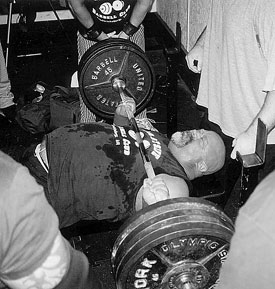 Strength is also determined by neural effciency. If you spend an hour a day shooting baskets, you’ll presumably get better and better, and this is to a large degree because of an increase in neural efficiency. The same thing happens when you lift weights your muscles get used to making that particular movement, and they become more effcient in lifting a weight. Part of this is accomplished by recruiting more muscle fibers to handle the imposed workload. Increasing resistance, i.e., slapping more iron on the bar, will prompt your body to recruit more and more fibers, and generally, this “recruit” is again a subtype of the aforementioned Type II fibers. Again, it’s these fibers that are most susceptible to growth.
Strength is also determined by neural effciency. If you spend an hour a day shooting baskets, you’ll presumably get better and better, and this is to a large degree because of an increase in neural efficiency. The same thing happens when you lift weights your muscles get used to making that particular movement, and they become more effcient in lifting a weight. Part of this is accomplished by recruiting more muscle fibers to handle the imposed workload. Increasing resistance, i.e., slapping more iron on the bar, will prompt your body to recruit more and more fibers, and generally, this “recruit” is again a subtype of the aforementioned Type II fibers. Again, it’s these fibers that are most susceptible to growth.
All of these considerations have been factored into my Power Bench Program, and that’s what makes it so effective. However, before we get into the nuts and bolts of the program, let me briefly point out that, genetics aside, muscle growth depends heavily on environment, not whether or not you recycle your cans of Phosphagainª, but the kind of enviromnent you create for struggling to-grow muscle fibers. Muscle cells do not live in a vacuum-they are part of you and share in whatever mistreatment you subject yourself to. If you drink heavily or abuse drugs, your muscles suffer. If you don’t rest enough or don’t eat properly, they bear the brunt of it, too. Together, all of these things create a poor growing environment for muscles. What you have to keep in mind is that the primary function of all living things-including you-is merely to survive, and a living organism cannot waste energy on supefficial notions like building extra muscle. Therefore, it’s important to provide the proper
environment for muscle growth.
Discipline is the final key to ensuring the success of this program. One trick I’ve found useful is to tell people what my goal is-that way, if I don’t accomplish it, I look like a poor fool. Another good trick is to do the program with someone else. We’re competitive creatures by nature, and talking trash at someone because my bench press went up more than his or hers is admittedly an enjoyable pastime of mine.
Enough theory. Let’s get ready to r-u-m-b-l-e! !
The Split
No workout for a specific body part can be undertaken without considering how it will affect the whole body. This workout will probably require you to make some modifications to your normal workout.
For instance, this program is low rep, low volume, and high intensity, and it is based on a two-day split. In other words, you will work your whole body in the course of two workouts over two days, whether those days are consecutive or separated by a day off. This program also requires that you adopt a “push-pull” method. Working all the muscles involved in “pushing” on one day, namely chest, shoulders, and triceps, and working all the muscles involved in “pulling,” like biceps and back, on another, allows the two groups of muscles more time to recuperate. (I recommend working legs on the “pull” day simply because the “push” workout, involving three muscle groups instead of two, takes longer.)
Recommended Two day Split:
Day #1 Day #2 chest legs shoulders back triceps biceps abs calves
Your gut instinct, perhaps developed by years of habit, may rebel against this type of workout. However, it’s not just low volume and high intensity that make a strength program work-frequency is a critical variable. In most workout programs, you exhaust a muscle group and then let it rest again. The length of time between each workout is not considered a crucial consideration. But the more frequently you can perform a lift, the smaller each increase in resistance and the more likely your body will be able to adapt. This bench program requires that you take small incremental steps. Instead of trying to make large jumps every six or seven days, you make small jumps on your bench every three or four days. This makes for a much smoother and much more consistent climb.
You may find that one particular option fits either your schedule or recuperative powers best. Only you will be able to tell which suits your needs most efficiently.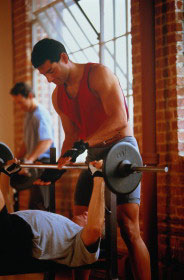 An Overview Of The Workout
An Overview Of The Workout
This program requires a different mentality, and it may require you to make some modifications to the way you’ve been training from workout to workout. The exercises should be of the basic, compound type, using high intensity while keeping volume low. This doesn’t mean you’ll be doing singles on shoulders or triceps, though. The lowest number of reps I recommend for shoulders, triceps, back, or biceps is six. Go ahead and use a higher number of reps for legs if you like, but your work should be of sufficient intensity to preclude doing 20 sets. Regardless, no workout should take more than an hour. Since this program is specifically designed to improve your bench press, there are some hard and fast rules that must be followed for optimum results. First of all, you must get two bench press sessions in every week. It’s also critical that you get at least three minutes in between each set on major lifts. This allows your muscle creatine levels to build back up and your lactic acid
levels to normalize.
Since your aim here is to increase your bench, you must limit shoulder and triceps work. For shoulders, I recommend working them after chest with a barbell press and/or side raises. For triceps, Iying triceps extensions or pushdowns will suffice. Make an effort to keep the work level for those body parts down to one, maybe two exercises for three or four sets. It’s better to keep those particular body parts a liffle undertrained rather than overtrained.
The following is a logical, productive total body workout. Keep in mind, though, that the details regarding the bench press are explained later on in this article:
Recommended Total Body Workout:
- DAY#1
Chest: Bench Press (high-rep day), Dumbbell flyes (3x8) Shoulders: Barbell press (3x6) Triceps: Triceps extension (3x8)
- DAY#2
Legs: Squats (3x6), Leg curls (3x8) Back: Barbell rows (3x6), Pulldowns (3x8) Biceps: Barbell curls (3x8)
- DAY#3
Chest: Bench press (low-rep day), Dumbbell bench (3x6) Shoulders: Dumbbell press (3x8), Lateral raises (3x8) Triceps: Triceps pushdowns (3x8)
- DAY#4
Legs: Squats (3x8), Straight-leg dead lifts (3x8) Back: One-arm rows (3x6), Close-grip pulldowns (3x8) Biceps: Incline dumbbell curls (3x8)
The Chest Workout-The Nuts And Bolts
STEP 1-Determining your one-rep max.
This program is very specific, and it allows you to chart your progress using computer-generated mathematical formulas. Don’t worry, though; you don’t need a computer to add up to 40 pounds to your bench press-all that work has been done for you and is included in the charts on the following pages. However, in order to make all of this work, you have to supply some data. The first bit of data you must supply is your one-rep max.
In order to do this, you must be well rested-that means you can’t train chest, shoulders, or triceps in the preceding 48 hours. Logic dictates that you attempt your one-rep max (1RM) the first thing in the workout. Safety dictates that you attempt it only after you’ve warmed up properly and obtained a conscientious spotter. Here’s how I deterrnine my 1RM:
- Warm up with a light weight for 10-12 reps. Rest and repeat.
- Rest for two minutes.
- Increase the weight for one you can handle comfortably for eight reps.
- Rest three minutes.
- Increase the weight to one you can handle for three to four reps.
- Rest three minutes.
- Add weight and attempt your 1RM.
- Increase weight gradually as needed, repeating steps six and seven until you reach your max.
Record it here:
1RM DATE:
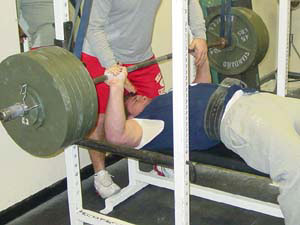 STEP 2 Plugging your IRM into the Progression Table on page 7.
STEP 2 Plugging your IRM into the Progression Table on page 7.
Take a look at the Progression Table on page 7. Looks imposing and complicated, right? Don’t worry. Once I explain a couple of things, it’ll make perfect sense. For the time being, pay attention only to the column on the extreme far left marked IRM. I bet you know what to do already. That’s right: find the number in that far left column that corresponds to your 1RM which you’ve already determined in the gym and recorded previously. Let’s say your 1RM was 290 pounds. Now, look at the first three numbers to the immediate right of your 1RM. In this case, they’re 190,215, and 230. These are the workout poundages you’ll use for Workout #1, and sure enough, if you look at the top of the column, you’ll see it plainly marked with a “1.” Right underneath that “1” are 3 shaded boxes, and they contain the numbers 8,6, and 5, and these correspond to the number of reps you’ll do in Workout #1.
To summarize, your 1RM of 290 indicates that in Bench Press Workout #1, you’ll do 1 set of 8 reps with 190, 1 set of 6 reps with 215, and 3 sets of 5 reps with 230.
STEP 3 Recording your numbers on the PowerBuilding Bench Press Program Workout Sheet on page 6.
Take a look at the Workout Sheet on page 6. Remember the number of reps and poundages we just calculated using the Progression Table? Write them down along with the date, in the boxes that cor respond to Workout #1. (Caution: don’ jump ahead and figure out all your work out poundages for the entire six-week pro gramÑI’ll explain why later.) Here’s a graphic to help make it clearer:
(See “Example”)
Now, all that’s left is to do PowerBuilding Bench Press Workout #1, along with working shoulders and triceps as recommended earlier. Once you complete this first bench workout, rest a day or two and work legs, back, and biceps; then we’ll figure out the poundages you need to use for PowerBuilding Bench Press Workout #2, which uses a slightly lower number of reps than your first bench workout.
Again, take a look at the Progression Table, finding your 1RM along the extreme left-hand column. This time, we’ll follow the column until we get to the numbers under Workout #2. Using our example 1RM of 290, we see that the numbers for our second workout are much heavier than those used in the first chest workout. Don’t worry, I expect you to progress quickly but not this quickly. The rep ranges for Workout #2 are less, so you’ll be able to do heavier weights. Plug those numbers, which, in the case of our example, are 210, 235, and 260, into the boxes that correspond to Workout #2 on the PowerBuilding Bench Press Program Workout Sheet on page 6.
The boxes for Workout #2 indicate that you’ll do 2 sets of 5 with 210 pounds, 2 sets of 3 with 235, and 1 set of 1 with 260.
Now, using the poundages indicated, do the workout. Immediately afterwards, work your shoulders and triceps again.
Simple, right? Only there’s one catch. PowerBuilding Bench Press Program #5, and every odd-numbered chest workout after that, has a test built into it to check your progress. Depending on whether you’re meeting, exceeding, or progressing slower than expected, you’ll need to make adjustments.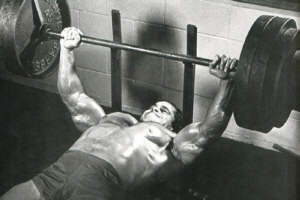 STEP 4 The Failure Test.
STEP 4 The Failure Test.
Before doing PowerBuilding Bench Press Program Workout #5, check the Progression Table again. Find your 1RM at the far left. Using our previous example of 290 pounds and following the horizontal column until we get to Workout #5, we see that there are only 2 numbers, one corresponding to a set of “6” and one corresponding to a set of “5.” What’s the deal? Did we screw up? Nope. Go ahead and plug the numbers corresponding to Workout #5 on the PowerBuilding Bench Press Workout Program. Just as before, you’ll do the indicated number of sets and reps. In this case, using our 1RM example of 290 and the corresponding weights indicated, we’ll do 1 set of 6 at 215 pounds and 2 sets of 5 at 245 pounds. However, the third box on the workout sheet indicates we should do another set, only the Progression Table hasn’t told you what weight to use, and the Workout Sheet doesn’t tell you how many reps to do.
Don’t worry. This is the Failure Test mentioned earlier. What you need to do is take the weight you used for Set #2, which in this case was 245 pounds, and rep out with it do as many as you can, using good form, and write this number down.
Now, check the following Failure Test Table:
This table is designed to test your progress. Some of you may be progressing very quickly, and your 1RM-the number you use to figure out your weights for each workout-will need to be adjusted upwards. Some of you may be slower gainers and consequently your 1RM will have to be adjusted downwards. And some of you are right on schedule and don’t need to adjust your 1RM at all.
Let’s say that you did 8 or more reps on your last set using 245 pounds. Look at the colurnn on the far right of the table under the heading marked “8 Reps.” Follow that column down until you find the number that corresponds with the weight you used to max out on. Follow the “8 Reps” column down until you see 245. Now move across to the left until you get to the 1RM column where it says 290. This would be your 1RM which you would plug into the Progression Table to figure out the weights for the next workout. Although, in this case, the 1RM is the same as when you started, this number can change. This is why we only write in our weights for one workout at a time.
Let’s say, however, that you only did three or fewer reps on your Failure Test. Find the column at the top that’s marked “3 Reps.” Follow it down until you find your Failure Test weight. Match that number up with the 1RM number on the far left column. This number is slightly less than the 1RM number you used previously on the Progression Table to chart your poundages. Use this new number to figure out your weights until the next Failure Test Workout.
If you got between 4 and 7 reps on the Failure Test, you don’t need to make any changes-you’re right on track.
Here’s a synopsis of what I just explained:
- 1.Use the Set #2 5-Rep weight for the Failure Test on Set #3 of oddnumbered workouts.
- 2. If you get between 4 and 7 reps on the Failure Test, no changes are needed.
- 3. If you reach failure at 3 reps or less OR after 8 or more reps, follow steps 4, 5, and 6.
- 4. Find the weight used for the test in the appropriate column of Failure Test Chart (3 Reps or 8 Reps).
- 5. Move left to 1RM column and record the new 1RM.
- 6. Go to the Progression Table and circle the new 1RM-this will be used to calculate the weights for your next workout.
A Few More Words On The Nuts And Bolts
As you can see, there are two different bench press workouts. One type, performed on odd days, typically employs one set of six reps, two sets of five reps, followed by one to complete failure. This is the higher volume workout and can be followed by one other chest exercise, like moderately heavy flyes for three sets of eight.
The other workout is a lower rep workout and is performed on even days. It typically uses sets of three reps, single-rep sets, and occasioqally a set of negatives (as indicated on th’e Progression Table and explained below). This can be followed by one other chest exercise, like flat dumbbell presses for three sets of six reps.
If you continue to follow the PowerBuilding Bench Program Workout Table and the weights indicated by the Progression Table and the Failure Test Table, there are only 6 weeks and 14 chest days (28 total workouts) between you and new, previously unrealized power.
I know all of this is complicated, but hey, who said building the body of your dreams was easy? One more time, let me list the most important features of this program:
- 1.Determine your one-rep max (1RM) bench press.
- 2. Find your 1RM in the far left-hand column of the Progression Table on page 7.
- 3. Move across the table to the right from your 1RM to the column under the appropriate workout number.
- 4. Fill in the weights in the PowerBuilding Bench Press Workout Sheet, matching the workout number and repetition subheads.
- 5. Find the weights for the next workout, one workout at a time.
- 6. Use the Failure Test on odd-numbered workouts to chart your progress and determine new lRMs as needed.
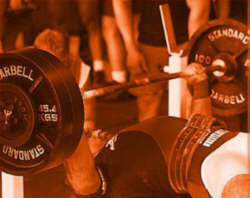 A Few Words On Some Of The Techniques Mentioned In This Program
A Few Words On Some Of The Techniques Mentioned In This Program
Negatives:
You may have noticed that the Progression Table, specifically Workouts 6, 8, and 10, includes one set of negatives. The use of heavy negatives can speed up the development of strength if not overused. On the average, people are capable of handling 120% more weight on the negative portion (eccentric) of a lift than the positive (concentric).
On the days indicated on the Progression Table, you’ll be doing one set-one rep-of a heavy negative. This will be your last set for that day. Make sure you have a spotter, though, or else you’ll have a caved-in chest to show for your efforts.
If possible, use a power rack, too. Grip the bar as you would normally for the bench, then have your partner help you unrack the weight. Unlock your elbows, and then, as the weight starts to lower, resist it as much as possible all the way down. Then, press the weight back up with help from your spotter and rack the weight.
Going To Failure:
I’ve mentioned “going to failure” several times in this article, but I don’t think the method can be overemphasized or overexplained. Although complete muscular failure seems self-explanatory, there’s more to it than just stopping when the weight becomes too heavy. Complete failure only comes when you’ve tapped into your hidden reserve of will and strength-it comes only after you’ve done a rep or two past what your muscles tell you they can do. It might take slowing the pace down a little during the set (while always keeping good form), or it might take calling on that previously untapped will and determination, but going to failure is a great way to fatigue the muscle and stimulate new growth.
Going to failure, legitimate failure, is also the gauge that will let you know how you’re progressing and when to make adjustments to this program.
Conclusion
At the end of your PowerBuilding Bench Press Program, you should take at least 2 or 3 weeks and not train with more than 80% of your one-rep maximum. For example, after my 6-week peaking program where I added 55 pounds to my bench press, I took 3 weeks and just did moderate to light bench press workouts. My new bench press maximum was 405 pounds, so I just did 3 sets of 8 with 275, along with some light dumbbell flyes (3xlO with 60 lb dumbbells). I did this workout once a week, three weeks in a row, and then I started another six-week PowerBuilding Bench Press Program.
Remember, knowledge is not power. Applied knowledge is power. You now have the knowledge to build incredible strength on the bench press. It’s up to you to use it! Now go for it!
If you’d like more information on Shawn’s customized PowerBuilding Workout Programs, just call 1-800-6158500 (and ask for Dept. #2135), outside the U.S. and Canada, call 303-279-3077, and Shawn will send you a complete information package. Shawn guarantees that he can design a complete program for you. Whether your goal is to gain size and strength, lose bodyfat and tone up, or gain strength and speed for improved performance in a sport, he’s got a program that he can custom tailor to help you achieve your goals.
Shawn Phillips’ custom-designed training programs are probably 20 years ahead of their time. In the future, everyone will likely train this way to get maximum results!
Copyright @ 1995, Muscle Media 2000, P.O. Box 277, Golden, CO 80402PDF Worksheets & Tables
Misc Tables: Failure Table, Schedules, and Progression Table example. (44k)
Workout Sheet: Bench Program workout sheet. (424k) Plug in numbers from Progression Table here.
Progression Table: The table that provides the poundages for the workouts. (392k)
 Critical Bench Program
Critical Bench Program
This bench press program is a power program designed to help you increase your one rep max by an average of fifty pounds during the ten week training cycle. It is different from other programs because you are provided with the actual weights you will be using on bench day and given a full body lifting split to follow. Over 3500 powerlifters, weekend warriors, and athletes have had success with our system. Get more in depth information by clicking here. If you’re ready to order now be sure you know your one rep max. You can look it up on our chart.































